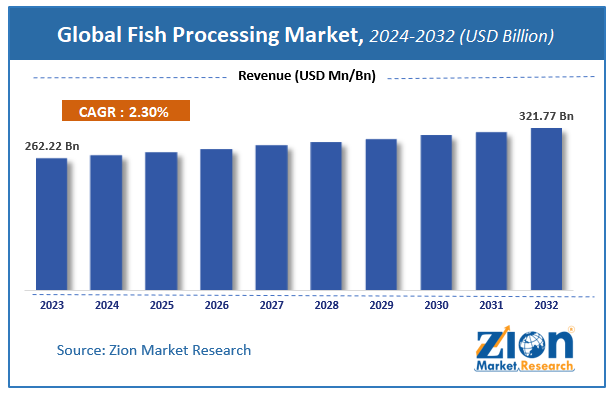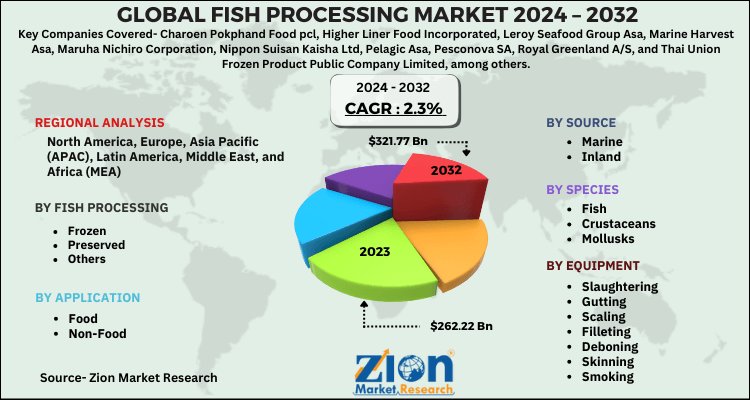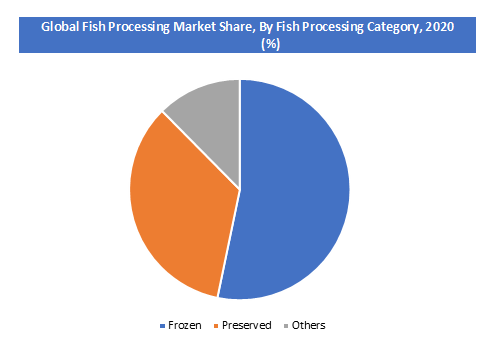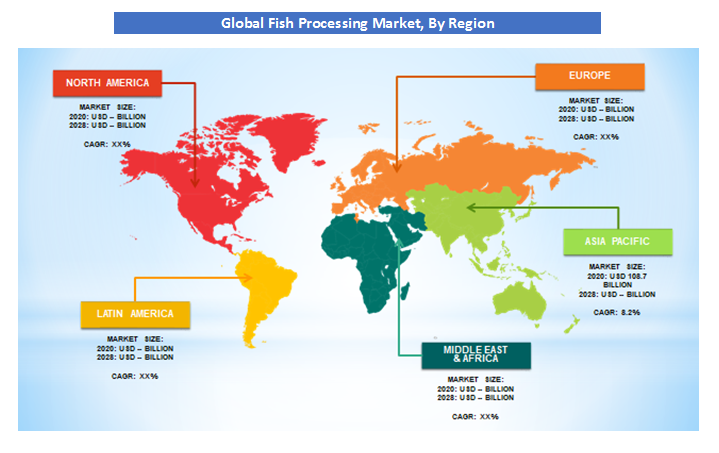Global Fish Processing Market Size, Share Report, Analysis, Growth, 2032

Global Fish Processing Market By Fish Processing Category (Frozen, Preserved And Others), By Application (Food, Non-Food), By Source (Marine And Inland), By Species (Fish, Crustaceans, Mollusks And Others), By Equipment (Slaughtering, Gutting, Scaling, Filleting, Deboning, Skinning, Smoking And Others): Global Industry Perspective, Comprehensive Analysis and Forecast, 2024 - 2032
| Market Size in 2023 | Market Forecast in 2032 | CAGR (in %) | Base Year |
|---|---|---|---|
| USD 262.22 Billion | USD 321.77 Billion | 2.3% | 2023 |
Global Fish Processing Market Insights
According to Zion Market Research, the global Global Fish Processing Market was worth USD 262.22 Billion in 2023. The market is forecast to reach USD 321.77 Billion by 2032, growing at a compound annual growth rate (CAGR) of 2.3% during the forecast period 2024-2032. The report offers a comprehensive analysis of the market, highlighting the factors that will determine growth, potential challenges, and opportunities that could emerge in the Global Fish Processing Market industry over the next decade.
Fish Processing Market: Overview
Fish processing is widely used for conservation, as it helps to keep fish fresh for longer periods of time with minimal loss of taste, flavor, aroma, or nutritional value. Fish processing refers to activities involving fish and fishery products. The process starts with the capture of the fish and continues until the final product is delivered to the customer. All aquatic organisms that are processed are included in this category. Because fish is a perishable food, proper storage is required to extend its shelf life and maintain nutritional quality. Many people are becoming interested in dried fish, such as shrimp, dried fish, octopus, dried oysters, and so on. Furthermore, well-known fish preservation techniques include hardening, salting, drying, and smoking. One of the main advantages of fish processing is that it contributes to the sustainable use of marine resources, increasing market demand for more processed fish. Ozone has been found to improve the freshness of raw fish (seafood).
Fish Processing Market: COVID-19 Impact Analysis
COVID-19 protective measures implemented across the US and the rest of the world in March 2020, according to analysts, had an almost immediate impact on seafood sector sales. Commercial fish landings revenue increased by 3% in January and February, indicating a strong start to the year. Revenues, on the other hand, decreased month after month, from a 19 percent drop in March to a 45 percent drop in July. When compared to five-year averages and adjusted for inflation, this translates to a 29 percent decrease over those seven months. According to the NOAA, restaurant closures, social distancing protocols, and other safety measures contributed to losses in other sectors of the seafood economy. COVID-19 had an impact on 78 percent of aquaculture, aquaponics, and related businesses by the end of the second quarter of 2020, with 74 percent reporting lost sales.
Fish Processing Market: Growth Factors
The high nutritional value of fish, the growth of the aquaculture industry, and increased public health awareness are the main market drivers for this industry. The health benefits and high nutritional value of fish and fishery products are driving this market. The growth of the non-food processing application mark is being aided by rising health concerns and the aquaculture industry. In the near future, the global market is expected to be strengthened by the introduction of modern technology and the dynamics of fishing vessels. Moreover, government support for fishing activities and technological advancements energizes the global fish handling market. Increased awareness of the health benefits and nutritional value of seafood has led to an increase in seafood consumption around the world, which is expected to drive market growth over the forecast period. Another factor driving the market growth is various government initiatives to support the aquaculture industry.
Another factor expected to drive the growth of the global fish processing market during the forecast period is the rising demand for fish oil in various industries and industries. The demand for seafood is skyrocketing around the world. This allows producers to increase their production scale by using more efficient equipment. Demand for fish processing equipment is expected to rise as a result of the rise of health-conscious consumers, particularly in North America and Europe.
Global Fish Processing Market: Report Scope
| Report Attributes | Report Details |
|---|---|
| Report Name | Global Fish Processing Market |
| Market Size in 2023 | USD 262.22 Billion |
| Market Forecast in 2032 | USD 321.77 Billion |
| Growth Rate | CAGR of 2.3% |
| Number of Pages | 115 |
| Key Companies Covered | Charoen Pokphand Food pcl, Higher Liner Food Incorporated, Leroy Seafood Group Asa, Marine Harvest Asa, Maruha Nichiro Corporation, Nippon Suisan Kaisha Ltd, Pelagic Asa, Pesconova SA, Royal Greenland A/S, and Thai Union Frozen Product Public Company Limited, among others |
| Segments Covered | By Fish Processing, By Application, By Source, By Species, By Equipment, And By Region |
| Regions Covered | North America, Europe, Asia Pacific (APAC), Latin America, Middle East, and Africa (MEA) |
| Base Year | 2023 |
| Historical Year | 2018 to 2022 |
| Forecast Year | 2024 - 2032 |
| Customization Scope | Avail customized purchase options to meet your exact research needs. Request For Customization |
Fish Processing Segment Analysis Preview
The convenience and instant cooking attributes to the highest popularity of fish products among consumers in 2023. Frozen held the majority of the market share in 2023. Furthermore, when it comes to frozen foods, nutritionists recommend deep-frozen foods because they are of the highest quality. When the fish is caught offshore, it is immediately processed and frozen at -40 degrees for a few hours. This procedure prevents microbial growth and the loss of nutrients by reducing natural oxidation and preserving freshness. In fact, it has a nutritional quality that is several times that of fresh fish found in markets. In addition, in the forecast period, the preserved segment is expected to grow at the fastest CAGR of 4.2 percent. The goal of fish processing and preservation is to delay or prevent enzymatic, bacterial, and chemical deterioration and keep the fish fresh in a condition as close to that of fresh fish as possible. Preserved and others form the fish processing segment.
Application Segment Analysis Preview
The demand for processed fish has been rising as a result of a variety of factors, including the diversification of fish products offered by fish processors and manufacturers, as well as changing consumer eating habits as a result of the inclusion of fish products in their daily diets. Non-foods form the other type of application segment.
Source Segment Analysis Preview
The marine segment contributes the most revenue, which can be attributed to the use of modern fish farming techniques and the availability of a wide variety of fish. Due to increased marine capture rates for both coastal and deep sea fish, which are used for processing in most Asian and European countries, the marine segment is dominating the market by source. Inland forms the other type of source segment.
Species Segment Analysis Preview
The fish segment accounted for the largest market share in 2023, owing to rising fish consumption and rising demand for low-fat and high-quality protein, which is expected to drive market growth. Furthermore, fish is a high-protein, low-fat food with a variety of health benefits. White-fleshed fish, in particular, is lower in fat than any other animal protein source, and oily fish is high in omega-3 fatty acids, which are essential for prenatal and postnatal neurological development. In addition, due to its micronutrients and healthy fats, the crustacean segment is expected to grow at the fastest CAGR of 4.6 percent during the forecast period. Mollusks And others form the species segment.
Equipment Segment Analysis Preview
The slaughtering segment led the market with the equipment because this equipment is corrosion-free and available with various cut types designed for a variety of fishes. Gutting, Scaling, Filleting, Deboning, Skinning, Smoking, and others form the segment
Regional Analysis Preview
In the Fish Processing market, Europe is the most dominant region. They have a wealth of resources, including ships and advanced machinery, that are expected to boost the local economy in the future. Cold-rolled and hot-smoked fish preservation methods are widely used in European countries. Cauldrons, clams, sardines, oysters, and cod are in high demand in Portugal, which is the fastest-growing region in Europe. Fishing is the main occupation in some European countries, such as Portugal, Spain, Poland, and Denmark, and it contributes significantly to GDP growth. They are the most successful exporters to North America and Europe.
When compared to markets in other regions, the Asia Pacific market dominates the global fish processing market in terms of revenue contribution with a CAGR of 8.2% during the forecast period. Over the next ten years, the Asia Pacific market is expected to grow at a faster rate in terms of revenue than the rest of the world. People's changing living standards, combined with rising demand for seafood in the region's countries, are expected to drive market growth in the region over the forecast period. In response to rapid urbanization and diet diversification, the processed seafood market in the region is currently undergoing a significant transformation. In addition, consumer demand for convenience and processed seafood in the region's food sector provides profitable growth opportunities and diversification.
Key Market Players & Competitive Landscape
Some of key players in fish processing market include
- Charoen Pokphand Food pcl
- Higher Liner Food Incorporated
- Leroy Seafood Group Asa
- Marine Harvest Asa
- Maruha Nichiro Corporation
- Nippon Suisan Kaisha Ltd
- Pelagic Asa
- Pesconova SA
- Royal Greenl and A/S
- hai Union Frozen Product Public Company Limited
The major players in this market have used a variety of strategies to increase their global presence and market share. Some of the key strategies used by market players to achieve growth in the global fish processing industry include partnerships, agreements, collaborations, acquisitions, and new product launches. Companies have been encouraged to adopt these strategies by the rising demand for processed fish products and the high growth rate of fisheries and aquaculture in emerging countries. Market participants are focusing on forming partnerships to share biotechnology-related technical know-how that can boost marine productivity.
The global fish processing market is segmented as follows:
By Fish Processing
- Frozen
- Preserved
- Others
By Application
- Food
- Non-Food
By Source
- Marine
- Inland
By Species
- Fish
- Crustaceans
- Mollusks
- Others
By Equipment
- Slaughtering
- Gutting
- Scaling
- Filleting
- Deboning
- Skinning
- Smoking
- Others
By Region
- North America
- The U.S.
- Canada
- Europe
- France
- The UK
- Spain
- Germany
- Italy
- Rest of Europe
- Asia Pacific
- China
- Japan
- India
- South Korea
- Southeast Asia
- Rest of Asia Pacific
- Latin America
- Brazil
- Mexico
- Rest of Latin America
- Middle East & Africa
- GCC
- South Africa
- Rest of Middle East & Africa
Table Of Content
Methodology
FrequentlyAsked Questions
The global fish processing market was valued at USD 262.22 Billion in 2023.
The global fish processing market is expected to reach USD 321.77 Billion by 2032, growing at a CAGR of 2.3% from 2024 to 2032.
The continuous rise in seafood demand, changing consumer dietary habits, and consumer demand for differentiated and value-added seafood products have all been identified as major drivers of the fish processing market.
Europe held a share of over 37.56% in the global fish processing market. This is attributable to the wealth of resources, including ships and advanced machinery, that are expected to boost the local economy in the future.
Some of key players fish processing market include Charoen Pokphand Food pcl, Higher Liner Food Incorporated, Leroy Seafood Group Asa, Marine Harvest Asa, Maruha Nichiro Corporation, Nippon Suisan Kaisha Ltd, Pelagic Asa, Pesconova SA, Royal Greenland A/S and Thai Union Frozen Product Public Company Limited, among others.
The term fish processing refers to the myriad of processes and procedures that are utilised in the preparation, preservation, and packaging of fish and other seafood items for human consumption. The preservation of the fish's nutritional and sensorial properties, as well as the extension of its shelf life, are the primary objectives of fish processing. Fish processing encompasses a broad spectrum of activities, ranging from the most fundamental gutting and cleaning to more complex procedures including filleting, smoking, canning, freezing, and dehydrating the fish. These procedures can be carried out singly or in conjunction with one another to produce a wide range of goods, including fresh, frozen, or canned fish; smoked salmon; fish jerky; fish sticks; and a great number of other varieties of fish-based foods.
List of Contents
GlobalMarket InsightsFish Processing Overview Fish Processing COVID-19 Impact Analysis Fish Processing Growth FactorsGlobalReport ScopeFish Processing Segment Analysis PreviewApplication Segment Analysis PreviewSource Segment Analysis PreviewSpecies Segment Analysis PreviewEquipment Segment Analysis PreviewRegional Analysis Preview Key Market Players Competitive LandscapeThe global fish processing market is segmented as follows:RelatedNews
HappyClients
Zion Market Research
Tel: +1 (302) 444-0166
USA/Canada Toll Free No.+1 (855) 465-4651
3rd Floor,
Mrunal Paradise, Opp Maharaja Hotel,
Pimple Gurav, Pune 411061,
Maharashtra, India
Phone No +91 7768 006 007, +91 7768 006 008
US OFFICE NO +1 (302) 444-0166
US/CAN TOLL FREE +1 (855) 465-4651
Email: sales@zionmarketresearch.com
We have secured system to process your transaction.
Our support available to help you 24 hours a day, five days a week.
Monday - Friday: 9AM - 6PM
Saturday - Sunday: Closed








